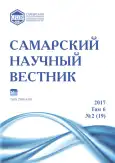Assessment of ecological state of the Posyet Bay (the Sea of Japan) by heavy metals content in brown algae
- Authors: Khristoforova N.K.1,2, Kobzar A.D.1
-
Affiliations:
- Far Eastern Federal University
- Pacific Institute of Geography of Far East Branch of Russian Academy of Sciences
- Issue: Vol 6, No 2 (2017)
- Pages: 91-95
- Section: 03.02.00 – General Biology
- URL: https://journals.rcsi.science/2309-4370/article/view/21804
- DOI: https://doi.org/10.17816/snv201762118
- ID: 21804
Cite item
Full Text
Abstract
The paper contains the study of heavy metals in three species - Sargassum miyabei, Sargassum pallidum, Cystoseira crassipes in the coastal waters of the Posyet Bay. The analysis of the spatial distribution of trace elements revealed the highest contents of zinc, copper and nickel in the Troitsa Bight, due to recreational pressure and a high concentration of nickel and cadmium in Sivuchya Bight that was caused by transboundary atmospheric transport. All of detected concentrations exceed natural background values for the North-Western part of the Sea of Japan. The authors show that there has been a distinct change in the environmental situation in the the Posyet Bay since 1998: the concentration of lead has sharply decreased, the content of zinc, copper and cadmium has decreased, it could be connected with influence reduction in the free economic zone, located on the Chinese side on the Tumannaya River.
Full Text
##article.viewOnOriginalSite##About the authors
Nadezhda Konstantinovna Khristoforova
Far Eastern Federal University; Pacific Institute of Geography of Far East Branch of Russian Academy of Sciences
Author for correspondence.
Email: marineecology@rambler.ru
doctor of biological sciences, professor, head of Marine Ecology UNESCO Department; leading researcher of Geochemistry Laboratory
Russian FederationAnna Dmitrievna Kobzar
Far Eastern Federal University
Email: kobzar.ad@dvfu.ru
senior lecturer of Ecology Department
Russian FederationReferences
- Вышкварцев Д.И., Лебедев Е.Б. Проект экономического развития реки Туманган (TREDA) - угроза экосистеме мелководных бухт залива Посьета Японского моря // Биология моря. 1997. Т. 23, № 1. С. 51-55.
- Мощенко А.В., Ванин Н.С., Ламыкина А.Е. Рельеф дна, донных отложений и гидрологические условия российской части приустьевой зоны реки Туманной // Экологическое состояние и биота юго-западной части залива Петра Великого и устья реки Туманной. Владивосток: Дальнаука, 2000. Т. 1. С. 42-75.
- Шулькин В.М. Оценка загрязнения металлами вод реки Туманной и прилегающих морских вод // Экологическое состояние и биота юго-западной части залива Петра Великого и устья реки Туманной. Владивосток: Дальнаука, 2000. Т. 1. С. 76-85.
- Коженкова С.И., Христофорова Н.К. Биомониторинг содержания тяжелых металлов в морских прибрежных водах юго-западной части залива Петра Великого с использованием бурых водорослей // Экологическое состояние и биота юго-западной части залива Петра Великого и устья реки Туманной. Т. 3. Владивосток: Дальнаука, 2002. С. 33-41.
- Христофорова Н.К. Биоиндикация и мониторинг загрязнения морских вод тяжелыми металлами. Л.: Наука, 1989. 192 с.
- Bryan G.V., Hummerstone L.G. Brown seaweed as indicator of heavy metals in estuaries in south-west England // J. Mar. Biol. Ass. U. K. 1973. Vol. 53. P. 705-720.
- Fuge R., James K. Trace metal concentration in Fucus from the Bristol Channel // Mar. Pollut. Bull. 1974. Vol. 5, № 1. P. 9-12.
- Fowler S.W. Use of macroalgae as a reference material for pollutant monitoring and specimen banking // Monitoring environmental materials and specimen banking: Proc. Int. Workshop. Berlin. 1978. London. 1979. P. 247-260.
- Bryan G.V. Recent trends in research on heavy-metal contamination in the sea // Helgalander Meeresunters. 1980. Vol. 33. P. 6-25.
- Khristophorova N.K., Kozhenkova S.I. The use of the brown algae Sargassum spp. in heavy metal monitoring of marine Environment near Vladivostok, Russia // Ocean Polar Res. 2002. Vol. 24, № 4. P. 325-329.
- Чернова Е.Н., Христофорова Н.К., Вышкварцев Д.И. Тяжелые металлы в морских травах и водорослях залива Посьета Японского моря // Биология моря. 2002. Т. 28, № 6. С. 425-430.
- Strezov A., Nonova T. Monitoring of Fe, Mn, Cu, Pb and Cd levels in two brown macroalgae from the Bulgarian Black Sea coast // Environmental Analitical Chemistry. 2003. Vol. 83, No. 12. P. 1045-1054.
- Hedouin L., Bustamante P., Fichez R., Warnau M. The tropical brown alga Lobophora variegate as bioindicator of mining contamination in the New Caledonia lagoon: A field transplantation study // Marine Environmental Research. 2008. No. 66. P. 438-444.
- Akcali I., Kucuksezgin F. A Biomonitoring stady: Heavy metals in macroalgae from Eastern Aegean coastal areas // Marine Poll. Bullet. 2011. Vol. 62. P. 637-645.
- Brito G.B., Souza Th.L., Bressy F.C., Moura C.W.N., Korn M. A. Levels and spatial distribution of trace elements in macroalgae species from the Todos os Santos Bay, Bahia, Brazil // Marine Pollution Bulletin. 2012. No. 64. P. 2238-2244.
- Христофорова Н.К., Кобзарь А.Д. Бурыe водоросли-макрофиты как индикаторы загрязнения вод бухты Рудной тяжелыми металлами // Известия ТИНРО. 2012. Т. 168. С. 220-231.
- Шулькин В.М., Чернова Е.Н., Христофорова Н.К., Коженкова С.И. Влияние горнорудной деятельности на изменение химического состава компонентов водных экосистем // Геоэкология. Инженерная геология. Гидрогеология. Геокриология. 2014. № 6. С. 483-494.
- Христофорова Н.К., Гамаюнова О.А., Афанасьев А.П. Состояние бухт Козьмина и Врангеля (залив Петра Великого, Японское море): динамика загрязнения тяжелыми металлами // Известия ТИНРО. 2015. Т. 180. С. 179-186.
- Кобзарь А.Д., Христофорова Н.К. Мониторинг загрязнения прибрежных вод Амурского залива (Японское море) тяжелыми металлами с использованием бурой водоросли Sargassum miyabei Yendo, 1907 // Биология моря. 2015. Т. 41, № 5. С. 361-365.
- Чернова Е.Н., Коженкова С.И. Определение пороговых концентраций металлов в водорослях-индикаторах прибрежных вод северо-западной части Японского моря // Океанология. 2016. Т. 56, № 3. С. 393-402.
- Крепс Е.М. Об оценке сравнительно-физиологических факторов // I Совещ. Биогруппы АН СССР по физиологическим проблемам. М., Л.: Изд-во АН СССР, 1937. С. 31-32.
- Шулькин В.М. Металлы в экосистемах морских мелководий. Владивосток: Дальнаука, 2004. 279 с.
- Мур Дж.В., Рамамурти С. Тяжелые металлы в природных водах: Контроль и оценка влияния. М.: Мир, 1987. 288 с.
Supplementary files







